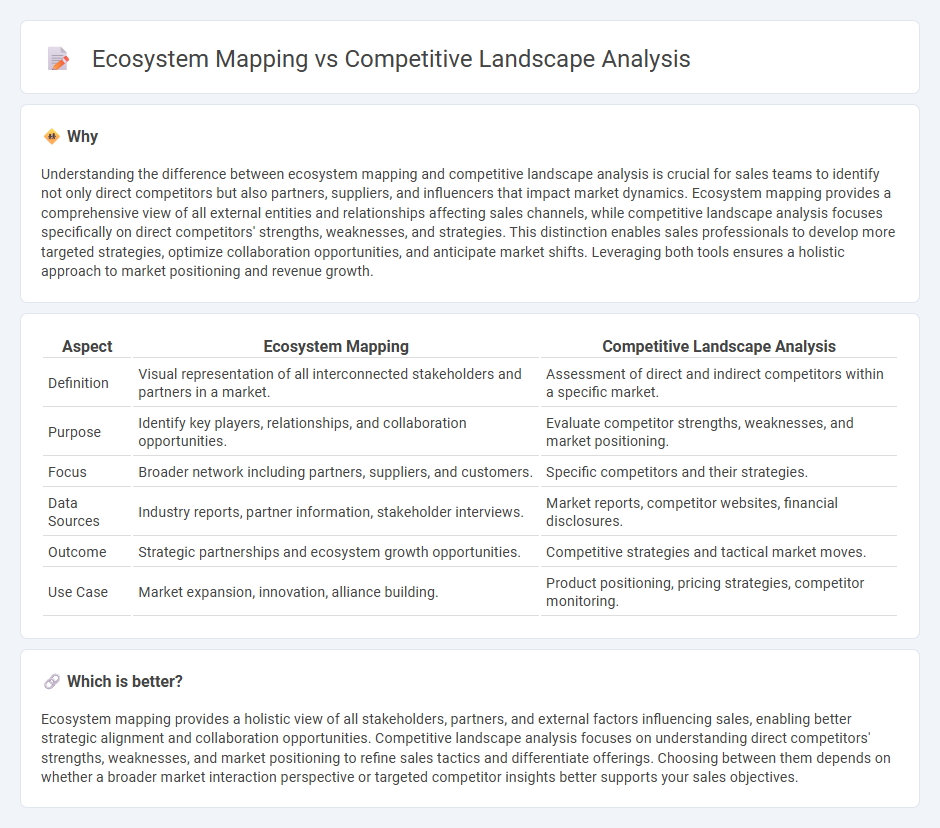
Ecosystem mapping identifies key players, relationships, and value exchanges within a market, providing a holistic view of business dynamics. Competitive landscape analysis focuses on direct and indirect competitors, assessing their strengths, weaknesses, market positioning, and strategies to gain competitive advantage. Explore these methods to enhance strategic sales decision-making and market positioning.
Why it is important
Understanding the difference between ecosystem mapping and competitive landscape analysis is crucial for sales teams to identify not only direct competitors but also partners, suppliers, and influencers that impact market dynamics. Ecosystem mapping provides a comprehensive view of all external entities and relationships affecting sales channels, while competitive landscape analysis focuses specifically on direct competitors' strengths, weaknesses, and strategies. This distinction enables sales professionals to develop more targeted strategies, optimize collaboration opportunities, and anticipate market shifts. Leveraging both tools ensures a holistic approach to market positioning and revenue growth.
Comparison Table
| Aspect | Ecosystem Mapping | Competitive Landscape Analysis |
|---|---|---|
| Definition | Visual representation of all interconnected stakeholders and partners in a market. | Assessment of direct and indirect competitors within a specific market. |
| Purpose | Identify key players, relationships, and collaboration opportunities. | Evaluate competitor strengths, weaknesses, and market positioning. |
| Focus | Broader network including partners, suppliers, and customers. | Specific competitors and their strategies. |
| Data Sources | Industry reports, partner information, stakeholder interviews. | Market reports, competitor websites, financial disclosures. |
| Outcome | Strategic partnerships and ecosystem growth opportunities. | Competitive strategies and tactical market moves. |
| Use Case | Market expansion, innovation, alliance building. | Product positioning, pricing strategies, competitor monitoring. |
Which is better?
Ecosystem mapping provides a holistic view of all stakeholders, partners, and external factors influencing sales, enabling better strategic alignment and collaboration opportunities. Competitive landscape analysis focuses on understanding direct competitors' strengths, weaknesses, and market positioning to refine sales tactics and differentiate offerings. Choosing between them depends on whether a broader market interaction perspective or targeted competitor insights better supports your sales objectives.
Connection
Ecosystem mapping identifies key stakeholders, partners, and customer segments within a sales environment, providing a framework to understand market dynamics and value exchanges. This holistic perspective enhances competitive landscape analysis by pinpointing direct and indirect competitors, market opportunities, and potential threats. Integrating both approaches enables sales teams to strategize effectively, optimize positioning, and drive revenue growth through informed decision-making.
Key Terms
**Competitive Landscape Analysis:**
Competitive landscape analysis identifies direct and indirect competitors, market positioning, product differentiation, and strategic advantages within an industry, providing a clear view of market dynamics and competitive pressures. This analysis uses metrics such as market share, pricing strategies, customer segments, and operational strengths to pinpoint opportunities and threats. Explore how competitive landscape analysis drives strategic decision-making and market positioning.
Market Share
Competitive landscape analysis evaluates market share by identifying key competitors, their revenue distribution, and market positioning to understand competitive intensity and potential growth opportunities. Ecosystem mapping examines relationships and interdependencies among various industry players, including suppliers, partners, and customers, highlighting collaborative dynamics that influence market reach and innovation. Explore further to grasp how these approaches impact market strategies and shareholder value.
Key Competitors
Competitive landscape analysis zeroes in on identifying and evaluating key competitors, their market positions, strengths, weaknesses, and strategic moves. Ecosystem mapping expands the scope to include all relevant stakeholders such as suppliers, partners, customers, and regulatory bodies influencing the market environment. Discover the benefits of integrating both approaches for comprehensive market insights.
Source and External Links
7 Steps To Create A Competitive Landscape Analysis - This guide outlines the process of identifying, researching, and evaluating competitors to inform business strategies and anticipate market changes.
The Essential Guide to Competitive Landscape Analysis - Provides insights into structuring a competitor landscape using frameworks like SWOT Analysis, Feature Matrix, and Perceptual Mapping.
8 Steps to Creating a Competitive Landscape Analysis - Offers a structured approach to understanding competitors by analyzing their products, strategies, and market trends.
 dowidth.com
dowidth.com